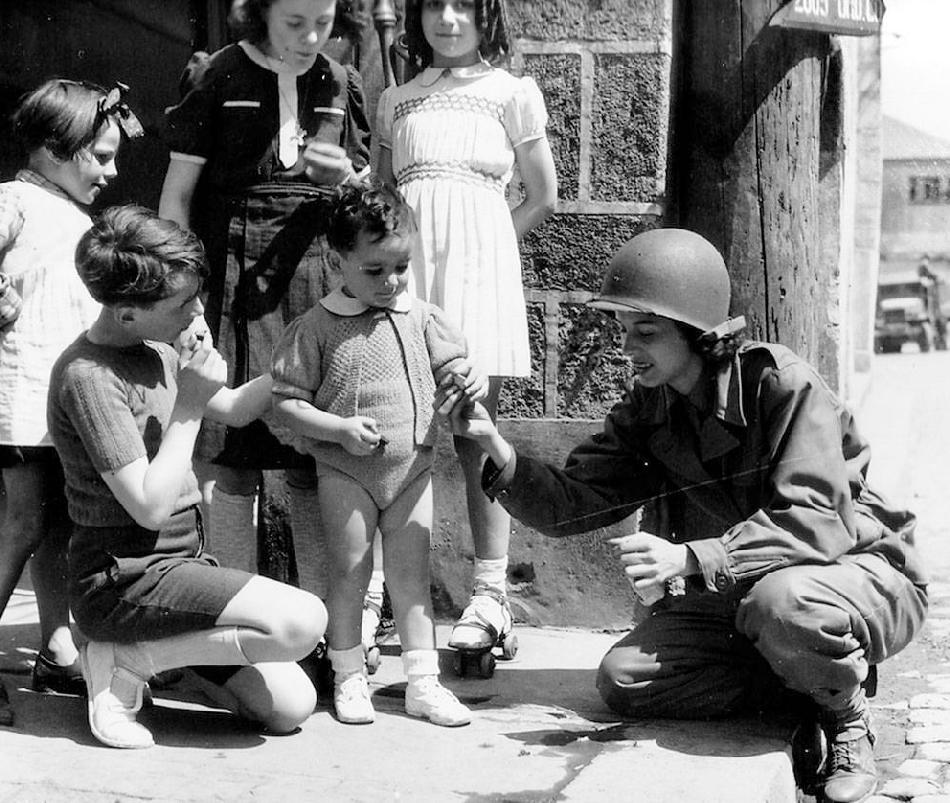
United States Army: World War II -- Womans Army Corps (WACs) (1942)

Figure 1.--The WACs Perfrmed most of the jobs male soldiers did, except going into combat. In static battlefields they could be kept in safe rear areas. When the breakout came in Normandy, the WACs moved forward with the men in the swift moving liberation of France Here a WAC makes feiends with some French children who during 4 years of German occupation and severe rationing did not get a lot of candy. Notice the deuce and a hlf ruck in the background--the most important truck of the War.
|
|
Some 150,000 American women served in the Women's Army Corps (WAC) during World War II. The WACs were the first women, other than nurses, to serve as part of the U.S. Army. Conress created the Woman's Army Auxilery Corps (1942), but when activated was shortened to the WACs (1943). This was not an easy innovation. Both the Army at all ranks and the public were skeptical abour woman soldiers. The idea of women in uniform was difficult for many some to accept.
Some of the more forward thinking military and political figures saw that women could provide additional resources for what would be the great military challenge in American history. Congresswoman Edith Nourse Rogers of Massachusetts met with General George C. Marshall, the Army's Chief of Staff (ealy 1941). She told him that she was going to introduce a bill to establish an Army women's corps which would be separate from the existing Army Nurse Corps. Rogers was aware of the women who had worked overseas with the Army under contract and as volunteers during World War I. They worked as communications specialists and dietitians. They worked without benefit of any official status. They were responsinle for obtaining their own food and quarters and received no legal protection or medical care. When they returned home, they were not entitled to the disability benefits or pensions available to all U.S. military veterans. Rogers was determined that this inequitabble treatment would not be repeated. Gen. Marshall decided to work with Rogers and to craft and sponsor an organization that would would not threaten the Army's existing culture. Rogers wanted the women's to be part of the Army so that women would receive equal pay, pension, and disability benefits. The Army wanted aeparatec corps. The final bill represented a compromise. Rogers introduced her bill (May 1941). It failed to receive serious consideration, however, until after the Japanese attack on Pearl Harbor propelled Anmeruica into the War (December 1941).. General Marshall's active support and congressional testimony helped the Rogers bill through Congress. After a long and acrimonious Congressional debate, the Rogers bill finally passed the House 249 to 86. The Senate approved the bill 38 to 27 (May 14). President Roosevelt signed the bill into law the next day (May 15). Many were surprised by the entusiam of women when offered the opportunity. Thousands of women served in the Army`s Women`s Army Corps (WAC) and Navy equivalent Women Accepted for Volunteer Emergency Service (WAVES). The WACs would serve in manycapacities, but administrative duries proved to be the mot important. They woun up going everywhere the men did, except into combat. The WAVES were a little different. WAVES were not allowed to serve on ships.
CIH -- WW II

Navigate the CIH World War II Pages:
[Return to Main U.S. Army World War II page]
[Return to Main U.S. Army page]
[Return to Main Arsenal of Democracy page]
[Return to Main military force page]
[Return to Main military style page]
[Biographies]
[Campaigns]
[Children]
[Countries]
[Deciding factors]
[Diplomacy]
[Geo-political crisis]
[Economics]
[Home front]
[Intelligence]
[POWs]
[Resistance]
[Race]
[Refugees]
[Technology]
[Bibliographies]
[Contributions]
[FAQs]
[Images]
[Links]
[Registration]
[Tools]
[Return to Main World War II page]
[Return to Main war essay page]
[Return to CIH Home page]
Created: 4:29 AM 6/10/2016
Last updated: 4:30 AM 6/10/2016
![]()


